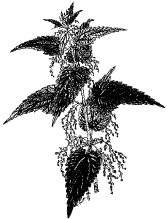
Family: Urticaceae
Genus:
Urtica
Species: dioica
Common Names:
Big string Nettle, Common Nettle,
Gerrais, Isirgan, Kazink, Nabat Al Nar,
Ortiga, Ortiga Mayor
Part Used: Root, Leaves
|
DESCRIPTION | |
| Properties/Actions: | Anodyne, Antirheumatic, Antiseptic, Astringent, Bactericide, Circulatory Stimulant, Depurative Diuretic, Emmenagogueue, Glactagogue, Hemostatic, Hypoglycemic, Hypotensive, Stomachic, Vasodilator, Vermifuge |
| Phytochemicals: | 2-methylhepten-(2)-on-(6), 5-hydroxytryptamine, Acetic-acid, Acetophenone, Acetylcholine, Alpha-tocopherol, Beta-carotene, Betaine, Bromine, Butyric-acid, Caffeic-acid, Calcium, Cellulose, Chlorophylls, Choline, Chromium, Ferulic-acid, Fluorine, Folacin, Formic-acid, Glycerol, Histamine, Koproporphyrin, Lecithin, Mucilage, P-coumaric-acid, Protoporphyrin, Scopoletin, Serotonin, SFA, Silicon, Sitosterol, Sitosterol-glucoside, Violaxanthin, Xanthophyllepoxide |
|
Traditional Remedy: |
One-half to one cup whole herb infusion 1-3 times daily or
1-3 ml of a 4:1 root tincture twice daily. 1 to 3 grams of dried leaf
and/or root in tablets or capsules can be substituted if desired. See Traditional Herbal Remedies Preparation Methods page if necessary for definitions. |
Nettles, or stinging nettles, are a perennial plant growing worldwide in wasteland areas. It grows 2-7 feet high with pointed leaves and flowers of white to yellowish panicles.(1,2) Nettles have a reputation for their savage sting from the hairs and bristles present on the leaves and stems. The stinging sensation from contact with the hairs is caused by the presence of formic acid, amines (histamine, serotonin and choline).(1) The tea of the leaves and stems has been used in traditional medicine as a poultice to stop bleeding. An account of this use is recorded by Francis P. Procher, a surgeon and physician in the Southern Confederacy.(2) The nettle leaves were recommended by the plant forager Euell Gibbons as a nutritious food and as a weight loss aid .(3) Many remarkable healing properties have been attributed to nettles, including prevention of baldness, allergic rhinitis and rheumatic pain.(4) However, the nettle root is recommended as a diuretic and, relatively recently for relief of benign prostatic hyperplasia (BPH).(5)
Nettle root constituents include lignans, scopoletin, sterols (beta sitosterol and sito-sterol-3-o-glucoside), oleannoic acid and 9-hydroxyl-10-trans-12-cis-octadecanoic acid. Other chemicals are the high molecular weight compounds such as five acids and neutral polysaccharides and isolectins.(5)
There are several clinical studies documenting the efficacy of nettle root
for BPH. Dr. Varro E. Tyler reported on a paper from the 1995 Congress on
Medicinal Plant Research that J.J. Lichius and colleagues showed a reduction in
prostatic growth potential in mice with the administration of a high dosage of
nettle root extract.(6) Another study using saw palmetto berries and
nettle root extracts to treat patients with BPH showed an inhibition of the
testosterone metabolites dihydrotestosterone and estrogen, thus proving to be an
effective treatment.(7) Some of the more resent research on BPH and
Nettles show that Nettles can interfere or block a chemical process in the body
that has been linked to prostate disorders. As men age, free-floating
testosterone becomes bound to albumin in a process called human sex
hormone-binding globulin (SHBG), removing its bioavailability to the body. This
chemical process is now believed to be linked to prostate disorders. In several
clinical studies, nettles has demonstrated the ability to block this process
which may well explain its documented effectiveness in the treatment of many
prostate conditions.(8 - 10) Since testosterone is a natural
aphrodisiac, and nettles makes more testosterone bioavailable for the body's use
by blocking SHBG, this may also explain why nettles has recently been regarded
with aphrodisiac properties.
| COUNTRY | ETHNOBOTANY WORLDWIDE USES |
| Brazil | Aphrodisiac, Depurative, Diuretic, Dropsy, Dyspnea, Gout, Prostatitis, Rheumatism, Urticaria |
| Canada | Ache, Alopecia, Anodyne, Ataxia(Locomotor), Bruise, Chest, Counterirritant, Parturition, Rheumatism |
| Elsewhere | Bactericide, Catarrh, Dandruff, Depurative, Diuretic, Hematemesis, Hematoptysis, Hemorrhage, Massage, Menorrhagia, Metrorrhagia, Paralysis, Shigellosis, Sore, Stomachic, Tumor, Vermifuge, Wound |
| Europe | Alopecia, Burn, Cholecystitis, Cholengitis, Constipation, Cosmetic, Cough, Depurative, Diuretic, Dropsy, Dyspnea, Epistaxis, Gout, Hair-Tonic, Hemoptysis, Homeopathy, Rheumatism, Shampoo, Tea, Urticaria |
| India | Anodyne, Counterirritant, Evil-Eye, Gout, Rheumatism, Sprain, Suppository, Swelling |
| Turkey | Asthma, Astringent, Blood, Bronchitis, Depurative, Diuretic, Emmenagogueue, Hemostat, Purgative, Rheumatism, Stimulant, Tonic, Vasoconstrictor, Vermifuge |
| U.S. | Ache(Back), Cancer, Epilepsy, Fit, Insanity, Rheumatism, Tantrum |
Footnotes: